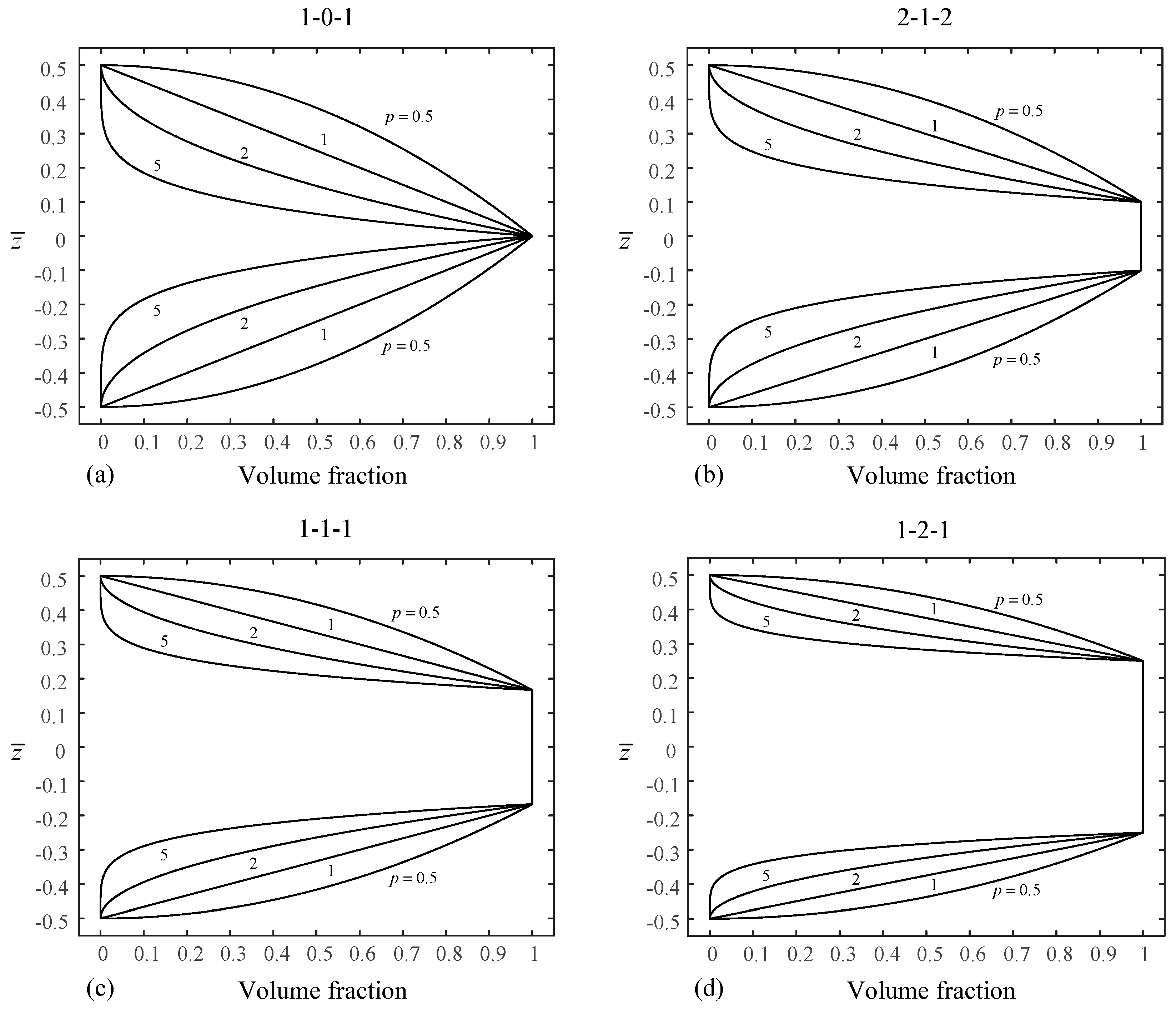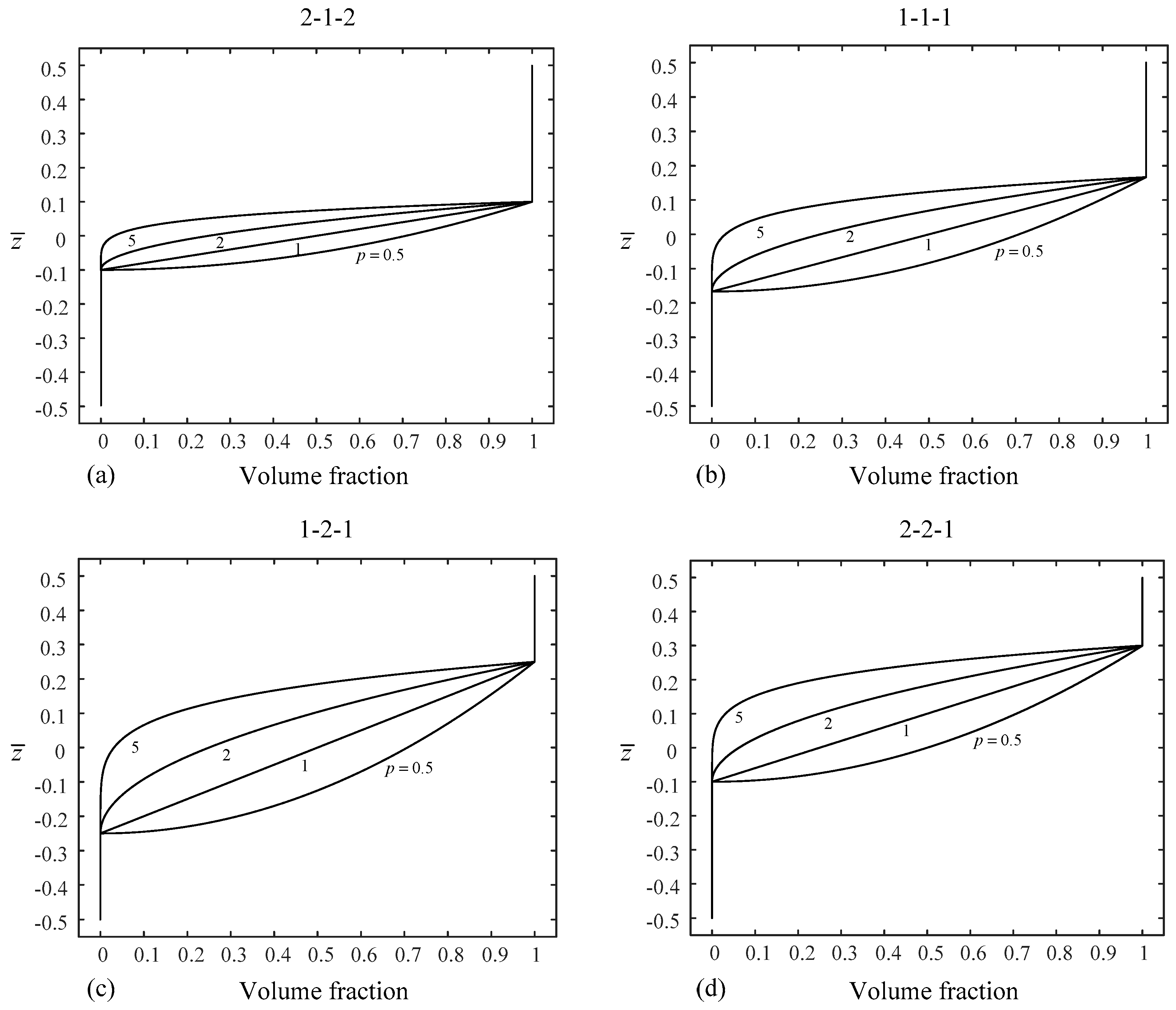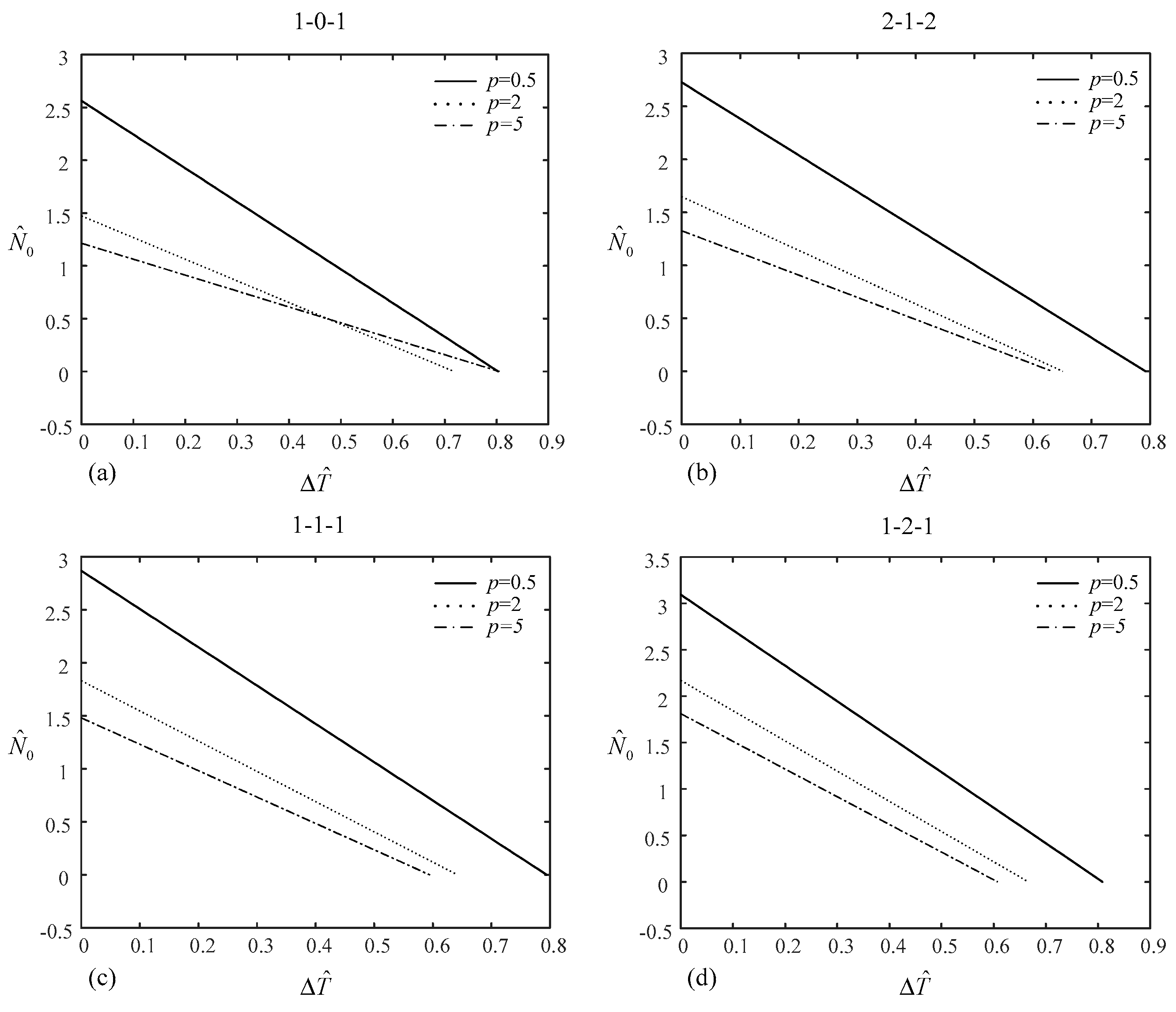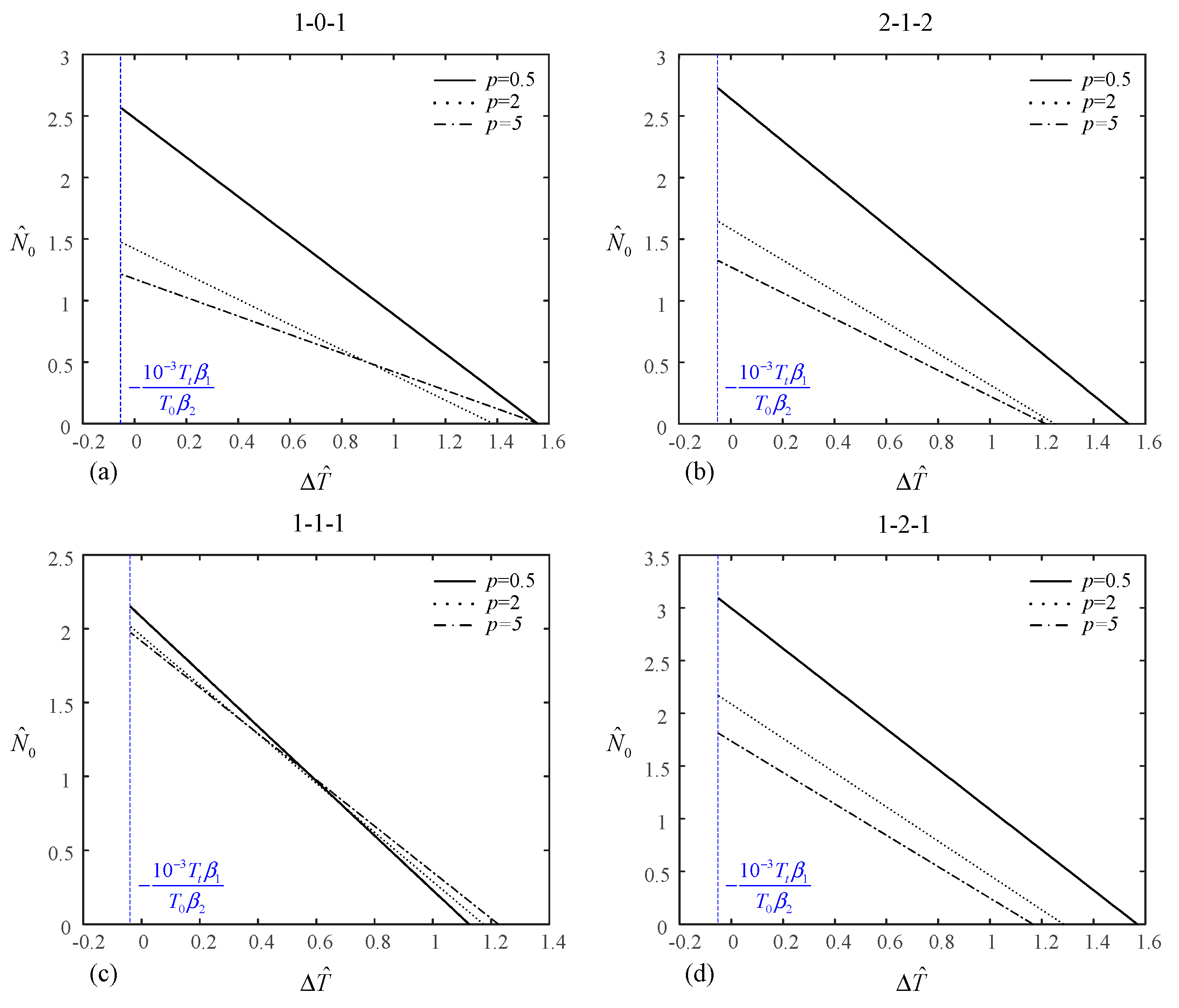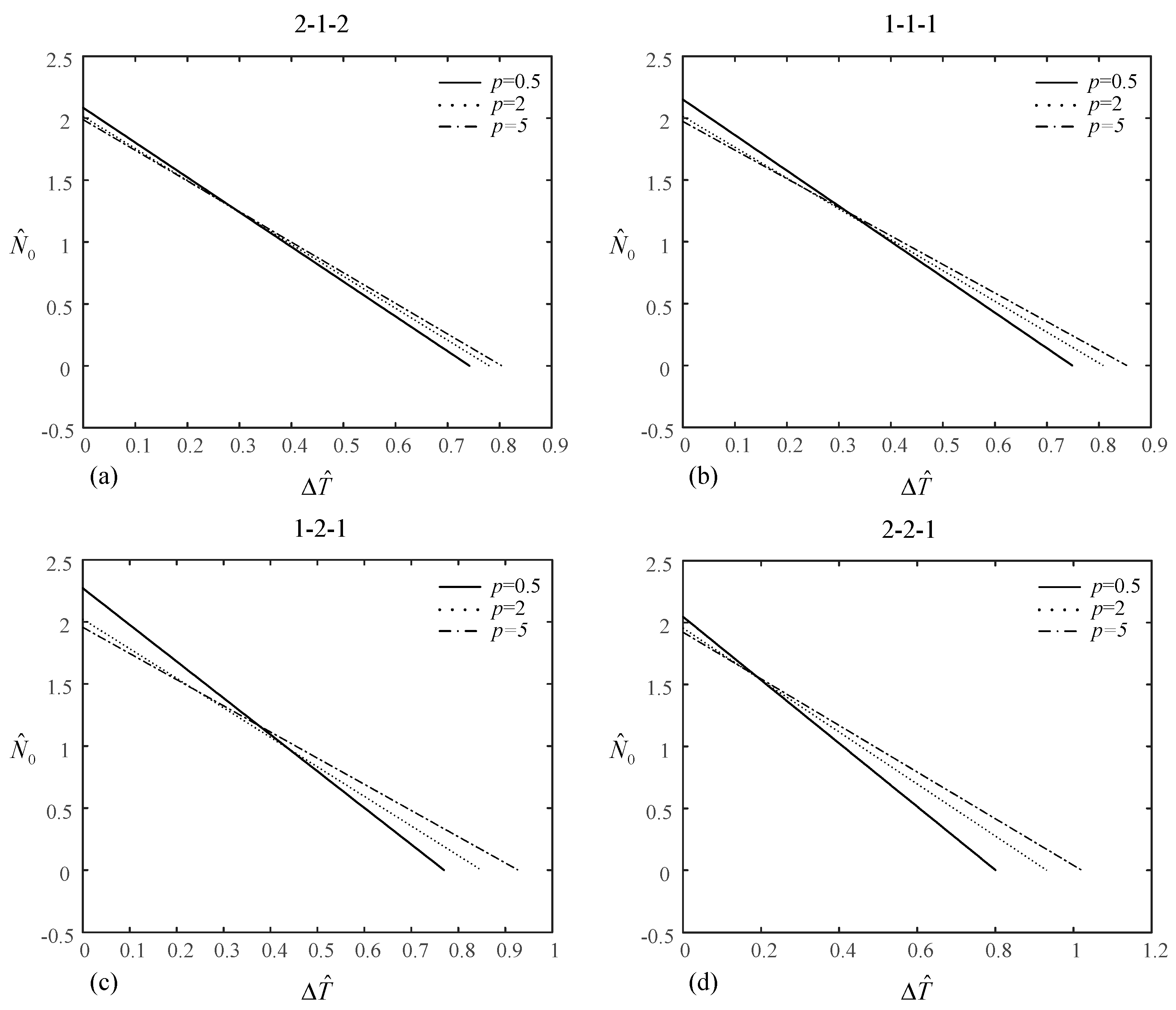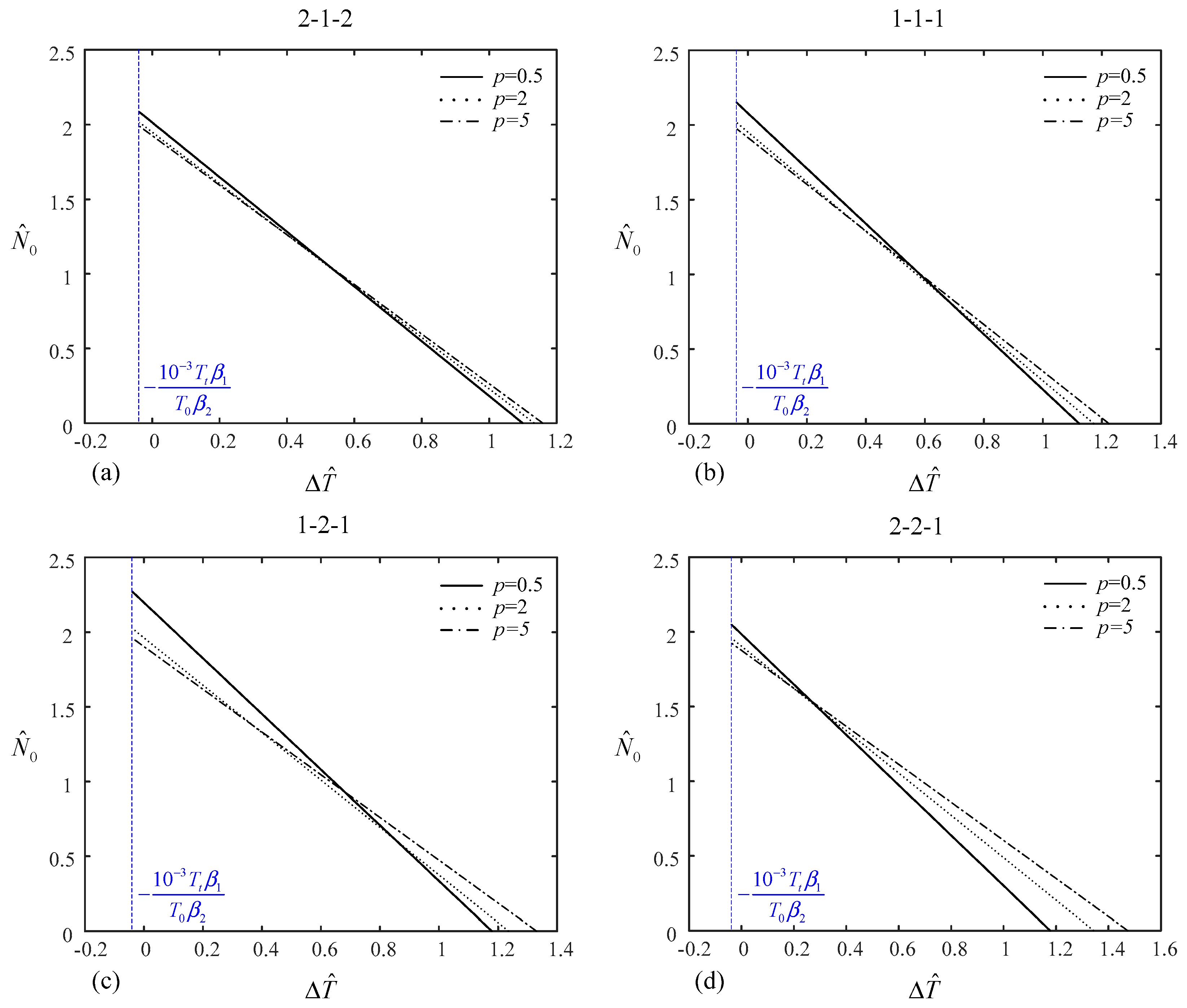1. Introduction
Sandwich structures have many benefits such as their light weight and high bending stiffness and thus have been broadly applied in aircraft, aerospace, flexible electronics, and biomedical areas [
1,
2]. A conventional sandwich structure has two homogeneous facesheets and a homogeneous core in between. Recently, the introduction of nonhomogeneous materials, such as the functionally graded materials (FGMs), has made sandwich structures become even more attractive [
3]. As the options for the facesheets and/or the core, FGMs help reduce the interlaminar stresses and thermal stresses, enhancing the mechanical and thermal performances of sandwich structures [
4,
5,
6]. In the literature, two types of FGM sandwich structures are mainly included: for type-A, sandwich structures with FGM facesheets and a homogeneous core [
7,
8,
9,
10,
11,
12,
13], and vice versa for type-B [
12,
13,
14,
15,
16,
17]. FGM sandwich structures combine the dual advantages of sandwich structures and FGMs, and thus offer unique potential in many fields of engineering, including planetary exploration landers, return capsules, submarines, and so on [
18,
19].
As one of the critical failure modes, buckling behavior of FGM sandwich structures has been studied by a number of researchers. However, most of them are restricted to FGM sandwich plates under mechanical load [
20,
21,
22,
23,
24,
25,
26,
27,
28,
29,
30,
31,
32,
33,
34] or thermal load [
35,
36,
37,
38,
39,
40,
41,
42]. Different methods are used, such as zig-zag plate theory, equivalent-single-layer (ESL) theories, unified formulation, and the mesh-free method. Very few publications considering both mechanical and thermal load can be found. In practice, FGM sandwich plates are commonly exposed to mechanical and thermal loads at the same time, so it is essential to include both for accurate prediction of the buckling problem. Based on a high-order ESL plate theory, Yang et al. [
43] employed the Galerkin-differential quadrature approach to analyze the buckling of type-A FGM sandwich plates under mechanical load and uniform temperature increment. Shen and collaborators [
44,
45] studied the buckling and postbuckling of type-A FGM sandwich plates under mechanical and thermal loads via a two-step perturbation technique. Based on a first-order ESL plate theory, Yaghoobi and Yaghoobi [
46] investigated the thermomechanical buckling of type-A FGM sandwich plates resting on an elastic foundation. Tung [
47] conducted a thermomechanical postbuckling analysis of FGM sandwich plates under mechanical load and uniform temperature rise, using a first-order ESL plate theory. References [
43,
44,
45,
46,
47] are mainly focused on type-A FGM sandwich plates or uniform temperature rise.
Based on the literature review, it was found that the limited amount of available work is not sufficient to provide a comprehensive understanding of buckling performance of FGM sandwich plates under mechanical and thermal loads. Recently, a four-variable ESL plate theory was developed to address the thermomechanical bending of FGM sandwich plates, which shows good accuracy and efficiency [
12]. This theory has not been extended to the analysis of the thermomechanical buckling behavior of FGM sandwich plates. Thus, the objective of this article is to use this four-variable ESL plate theory to investigate the thermomechanical buckling problem of simply supported FGM sandwich plates. In this study, both type-A and type-B FGM sandwich plates are included. Both uniform temperature rise, and graded temperature rise are considered. Power-law FGM is adopted herein. The material properties are assumed to be temperature-independent [
48,
49]. The governing equations are obtained from the principle of minimum total potential energy and solved via Navier Method. The present theory was verified by comparing calculated results with those from the existing literature. Numerical results were calculated considering the effects of volume fraction distribution and geometrical parameters on the thermomechanical buckling of FGM sandwich plates. In this framework, a linear relationship between the mechanical load and thermal load is presented.
2. Theoretical Formulation
Consider a rectangular FGM sandwich plate with constant thickness h, length a, and width b. The Cartesian coordinate system xyz is taken such that the xy plane (z = 0) coincides with the geometric mid-surface of the sandwich plate. In the present study, the sandwich plate is subjected to a system of uniform, in-plane, compressive loads at the side edges and a thermal load through the thickness.
Both type-A and type-B FGM sandwich plates are included. Since the composition distribution in FGMs is designable, three typical gradations are commonly used in the literature: power law, exponential law, and sigmoid law [
49,
50]. In the present study, the power law is adopted to describe the ceramic volume fraction.
2.1. Type-A Sandwich Plate: Sandwich Plates with FGM Facesheets and Homogeneous Core
In type-A sandwich plates, the sandwich core is homogeneous while the facesheets are functionally graded through the thickness, as shown in
Figure 1. The ceramic volume fraction of type-A sandwich plate is given by
where
is the volume fraction of
n-th layer and
p is the power index greater than or equal to zero.
2.2. Type-B Sandwich Plate: Sandwich Plates with Homogeneous Facesheets and FGM Core
In type-B sandwich plates, the facesheets are homogeneous while the core layer is functionally graded through the thickness, as illustrated in
Figure 1. The ceramic volume fraction of type-B sandwich plate is given as:
2.3. Material Properties
The effective material properties
P(n) for
n-th layer, such as the Young’s modulus
and the thermal expansion coefficient
at a point can be determined by the linear rule of mixture as
where subscripts
m and
c represent metal and ceramic, respectively. Since the Poisson’s ratio
varies only in a small range through the plate thickness, for simplicity, it is assumed to be constant [
33,
49].
2.4. Four-Variable ESL Plate Theory
An ESL plate theory containing four variables is used, of which the basic assumptions have been stated in references [
51,
52]. The displacement field of the present study is:
in which
where
u,
v, and
w represent the displacements in the
x,
y, and
z directions, respectively;
and
are the midplane displacements;
and
are the bending and shear parts of the transverse displacement
w, respectively.
2.5. Geometric Equations
The non-linear von Karman strain–displacement equations are
Using Equations (4) and (6), we get
where
The stress–strain relationships accounting for thermal effects for the
n-th layer can be written as
where Δ
T is the temperature change from the stress-free state. The elastic constants
of the
n-th layer are
2.6. Governing Equations
Energy methods can commonly be taken to derive the governing equations, such as the total potential energy principle [
53] and the principle of virtual displacements [
54]. The total strain energy of the FGM sandwich plate can be written as
The potential energy of external force is calculated by
where
and
represent distributed, compressive, in-plane forces in the
x and
y directions (per unit length).
In this study, the principle of minimum total potential energy is used, which takes the following form as
Substituting Equations (11) and (12) into Equation (13) obtains the governing equations of stability,
where the stress and moment resultants can be found in reference [
12], and
in which
3. Solution Procedure for Eigenvalue Problems
For a simply supported FGM sandwich plate of which the boundary conditions are expressed as
close-form solutions can be found, because, using Navier procedure, the displacement field can be expanded as the following form:
where
Umn,
,
, and
are unknowns to be determined.
and
.
The critical buckling loads and temperature increment of FGM sandwich plates subjected to a system of uniform in-plane compressive loads and () in thermal environment can be derived.
Assuming that there is a given ratio between
and
such that
and
, by substituting Equation (18) into Equation (14), one can obtain
where
The elements of matrix [
K] can be found in reference [
12]. Detailed expressions of matrices [
] and [
] are listed in
Appendix A.
For nontrivial solutions of Equation (19), the determinant
should be equal to zero, which is written by
Solving Equation (21) gives the critical buckling load with temperature increment or critical buckling temperature increment with in-plane compressive load, which will be presented in the following.
3.1. Critical Buckling Load
The critical buckling load without temperature increment is
where
A11,
B11,
C11,
D11,
F11,
H11,
J44 can be found in reference [
12]:
The critical buckling load with temperature increment is
3.2. Critical Buckling Temperature Increment under Uniform Temperature Rise
In this case, the temperature of the FGM sandwich plate is uniformly raised from initial temperature to final temperature in which the sandwich plate buckles. The temperature increment is .
By solving Equation (21), the critical buckling temperature increment without in-plane compressive load is shown to be
where
The critical buckling temperature increment with in-plane compressive load is
3.3. Critical Buckling Temperature Increment under Graded Temperature Rise through the Plate Thickness
The top surface temperature
is different from the bottom surface temperature
, which varies through the plate thickness according to
In which is the buckling temperature difference and is the temperature index ().
The critical buckling temperature increment without in-plane compressive load is
where
The critical buckling temperature increment with in-plane compressive load is
4. Numerical Results
In this section, comparative study is given to verify the current formulation. Considering the influence of volume fraction distribution and geometric parameters, as well as mechanical and thermal loads, several results are presented to provide sufficient insight to the thermomechanical buckling of FGM sandwich plates. Typical material properties for metal and ceramic used in the numerical examples are listed in
Table 1.
For convenience of expression and illustration, the sandwich plates are denoted according to the layer thickness ratio of the facesheets and core. For example, (1-2-1) sandwich plate has a total thickness of
h, core thickness of
h/2, and two facesheets of equal thickness of
h/4, and hence, in
Figure 1,
,
.
Figure 2 and
Figure 3 show the through-the-thickness variation of the ceramic volume fraction in type-A and type-B FGM sandwich plates for various values of
p = {0.5, 1, 2, 5}. Unless otherwise specified,
a/h = 10,
= 25 K and
.
4.1. Validation Study
The validation study is conducted from the following four aspects: mechanical buckling of type-A and type-B FGM sandwich plates, as well as thermal buckling of type-A and type-B FGM sandwich plates. For mechanical buckling, the FGM sandwich plates are made from aluminum (Al) and alumina (Al2O3), while for thermal buckling, they are made from titanium (Ti-6Al-4V) and zirconia (ZrO2).
For better comparison and illustration, the following relations are adopted [
11,
35]:
where
= 1 GPa.
Table 2,
Table 3,
Table 4 and
Table 5 shows the critical buckling load
and temperature increment of type-A and type-B sandwich plates for various layer thickness ratio and power index
p. Results calculated by other theories in the literature are also presented as benchmark results. As observed, for every aspect of the buckling problem, an excellent agreement is reached.
4.2. Buckling Analysis of Type-A Sandwich Plate under Mechanical and Thermal Loads
In this example, a simply supported, square, type-A sandwich plate under the effect of mechanical and thermal loads is considered. The combination of materials consists of titanium and zirconia. It is assumed that the plate is subjected to mechanical load and temperature increment under uniform or linear temperature rise in which the plate buckles.
Dimensionless mechanical load and temperature rise are used as
where
= 1 K.
Firstly, we calculate the dimensionless critical buckling load and temperature increment under uniform/linear temperature rise for type-A square sandwich plates for
p = 0.5 and 2, and various layer thickness ratios of 1-0-1, 2-1-2, 1-1-1, and 1-2-1. Then we apply 1/2 of the critical buckling temperature increment under uniform temperature rise to calculate the mechanical load. In addition, we apply 1/2 of the critical buckling load to calculate the temperature increment under uniform/linear temperature rise. These results are given in
Table 6.
represents the dimensionless mechanical load with 1/2 of the critical buckling temperature increment under uniform temperature rise;
and
represent the dimensionless critical temperature increment under uniform and linear temperature rise, respectively;
and
denote the dimensionless temperature increment under uniform and linear temperature rise with 1/2 of the critical buckling load. As observed,
and
, but
.
The relationship between and can be obtained from Equations (22), (24), (25), (27), (29) and (31).
For the uniform rise in temperature case,
For the graded rise in temperature case,
Figure 4 and
Figure 5 depict the relationship between temperature increment under uniform/linear temperature rise and mechanical load of the (1-0-1), (2-1-2), (1-1-1), and (1-2-1) type-A sandwich plates for
p = 0.5, 2, and 5. The relationship is linear, which can also be seen from Equations (34) and (35). With the increase in the temperature increment, the mechanical load decreases. This is expected, because a rise in temperature results in compressive internal force. In
Figure 4, when the value of temperature increment reaches its maximum, the value of mechanical load is zero and vice versa. However, in
Figure 5, when the value of mechanical load reaches its maximum, the value of temperature increment is
. This is the reason why
in
Table 6.
4.3. Buckling Analysis of Type-B Sandwich Plate under Mechanical and Thermal Loads
Similar work was also carried out for type-B FGM (Ti-6Al-4V/ZrO2) sandwich plates under the effect of mechanical and thermal loads.
Table 7 shows the values of dimensionless mechanical load with 1/2 of the critical buckling temperature increment under uniform temperature rise and dimensionless temperature increment under uniform and linear temperature rise with 1/2 of the critical buckling load for various layer thickness ratios and power index
p.
Figure 6 and
Figure 7 plot the relationship between temperature increment under uniform/linear temperature rise and mechanical load of the (2-1-2), (1-1-1), (1-2-1), and (2-2-1) type-B sandwich plates for
p = 0.5, 2, and 5. Similar conclusions can be drawn.

